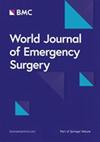Ultra minimally invasive surgical stabilization of Rib fractures (uMI-SSRF): reduction and fixation techniques to minimize the surgical wound
IF 5.8
1区 医学
Q1 EMERGENCY MEDICINE
引用次数: 0
Abstract
Rib fractures are common in trauma patients, often leading to complications such as pneumonia and prolonged hospitalization. Surgical Stabilization of Rib Fractures (SSRF) has become increasingly prevalent in treating severe cases. However, traditional approaches, like posterolateral thoracotomy, are invasive and cause significant muscle damage. Recently, muscle-sparing minimally invasive techniques have been introduced, yet they still require advanced reduction and fixation techniques to avoid complications. This study presents an “ultra” minimally invasive SSRF (uMI-SSRF) technique designed to minimize surgical wounds and soft tissue damage while maintaining the benefits of rib fixation. This study involved 76 patients with multiple rib fractures treated using the uMI-SSRF technique between August 2021 and December 2023. Preoperative chest tomography with 3D reconstruction was used for surgical planning. The technique employed small incisions (3–5 cm), muscle-sparing approaches, and advanced fixation techniques. Data on patient demographics, intraoperative details, and postoperative outcomes were collected. The mean patient age was 58 years, with 66% being male. On average, patients had 6.4 fractured ribs, and 3.5 ribs with 3.88 plates were fixed per surgery, achieving a fixation/fracture ratio of 59%. The average wound length was 4.2 cm, with a mean operation time of 122 min. Most patients required only one incision (74%). The median hospital length of stay was 7 days, with a pneumonia rate of 5%. No wound infections or implant-related complications were observed. The uMI-SSRF technique effectively reduces wound size and soft tissue damage in rib fracture stabilization while maintaining high fixation quality. This method shows promise for improving patient outcomes, reducing recovery time, and minimizing complications. Further studies with larger sample sizes and comparisons with other methods are warranted to verify the advantages of uMI-SSRF.超微创手术稳定肋骨骨折(uMI-SSRF):减少手术伤口的还原和固定技术
肋骨骨折是外伤患者的常见病,通常会导致肺炎和长期住院等并发症。肋骨骨折外科稳定术(SSRF)在治疗严重病例中越来越普遍。然而,后外侧胸廓切开术等传统方法具有创伤性,会对肌肉造成严重损伤。最近,出现了保护肌肉的微创技术,但仍需要先进的还原和固定技术来避免并发症。本研究介绍了一种 "超 "微创 SSRF(uMI-SSRF)技术,旨在最大限度地减少手术伤口和软组织损伤,同时保持肋骨固定的优势。这项研究涉及 2021 年 8 月至 2023 年 12 月期间使用 uMI-SSRF 技术治疗的 76 例多发性肋骨骨折患者。术前胸部断层扫描与三维重建用于手术规划。该技术采用了小切口(3-5 厘米)、肌肉保全方法和先进的固定技术。收集了患者的人口统计学、术中细节和术后效果等数据。患者平均年龄为 58 岁,66% 为男性。患者平均有 6.4 根肋骨骨折,每次手术固定了 3.5 根肋骨和 3.88 块钢板,固定/骨折比率为 59%。伤口平均长度为 4.2 厘米,平均手术时间为 122 分钟。大多数患者只需要一个切口(74%)。住院时间中位数为 7 天,肺炎发生率为 5%。未发现伤口感染或与植入物相关的并发症。uMI-SSRF 技术能有效减少肋骨骨折稳定过程中的伤口面积和软组织损伤,同时保持较高的固定质量。这种方法有望改善患者预后、缩短恢复时间并最大限度地减少并发症。为了验证 uMI-SSRF 的优势,有必要进行样本量更大的进一步研究,并与其他方法进行比较。
本文章由计算机程序翻译,如有差异,请以英文原文为准。
求助全文
约1分钟内获得全文
求助全文
来源期刊

World Journal of Emergency Surgery
EMERGENCY MEDICINE-SURGERY
CiteScore
14.50
自引率
5.00%
发文量
60
审稿时长
10 weeks
期刊介绍:
The World Journal of Emergency Surgery is an open access, peer-reviewed journal covering all facets of clinical and basic research in traumatic and non-traumatic emergency surgery and related fields. Topics include emergency surgery, acute care surgery, trauma surgery, intensive care, trauma management, and resuscitation, among others.
 求助内容:
求助内容: 应助结果提醒方式:
应助结果提醒方式:


